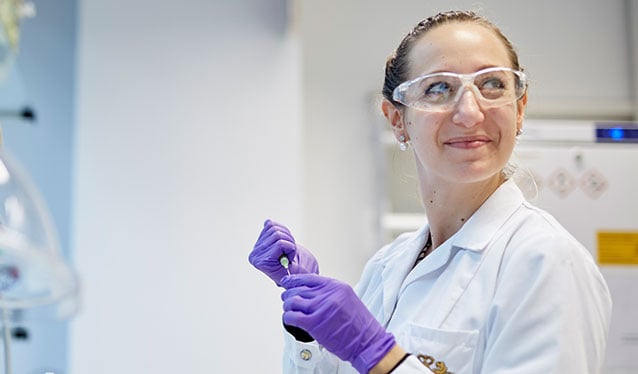What is tobacco harm reduction?
The best choice for any smoker is to quit nicotine and tobacco altogether. But better alternatives exist for adult smokers who would otherwise continue smoking cigarettes. This is tobacco harm reduction.
The problem with burning tobacco

The problem with burning tobacco
This is why tobacco harm reduction is critical
Instrumental music starts.
Moira Gilchrist, Chief Communications Officer for Philip Morris International, speaks to camera:
The policy of harm reduction has been around forever.
How harm reduction can end smoking
Stacey Kennedy, President, Americas Region and CEO of PMI’s U.S. business, speaks to camera:
Harm reduction for me is all about looking at the types of harms that the human population endures and in looking at how consumers can replace more harmful behaviors with less harmful behaviors.
Gizelle Baker, Vice President Global Scientific Engagement for Philip Morris International, speaks to camera:
There is some level of inevitability that you won't be able to completely abolish or get rid of something that is negative to our health.
Moira Gilchrist speaks to camera:
Harm reduction is really part and parcel of society.
Whether it be automobiles or cars, we have seat belts, we have safety features like airbags and so on.
Jacek Olczak, CEO of Philip Morris International, speaks to camera:
Many years ago we discovered that part of the big contribution to energy saving could be switched to light bulbs which consume much less energy so we replace the old product with the better product.
Stefano Volpetti, President, Smoke-Free Inhaled Products and Chief Consumer Officer, speaks to camera:
Harm reduction might be a complex topic.
In reality, PMI’s philosophy makes it very clear:
If you don't smoke, don't start,
If you smoke, quit,
If you don't quit, change.
Stacey Kennedy speaks to camera:
If we just expect the 1 billion smokers on the planet to just stop, history over the past decades has told us that's simply not going to happen.
Lars Dahlgren, President, Smoke-free Oral Products & CEO, Swedish Match, speaks to camera:
The fact of the matter is that a lot of people don't quit tobacco because they enjoy their products, they enjoy nicotine.
Harm reduction means providing better alternatives.
Stacey Kennedy speaks to camera:
We really have to make sure that there is a broad societal awareness of the fact that burning tobacco is what causes the harm.
Bin Li, Chief Product Officer for Philip Morris International, speaks to camera:
We can deliver a product that can still give you a sensory and taste that's very close to tobacco and we have reduced the harm.
Stacey Kennedy speaks to camera:
It has to be a replacement product that satisfies consumers, that gives them a similar ritual, but that yet scientifically and technologically reduces the harm that they would otherwise be exposed to.
Gizelle Baker, speaks to camera:
Obviously there's still some level of toxicants that you're being exposed to when you switch to these products but it's significantly less than cigarette smoke.
Badrul Chowdhury, Chief Life Sciences Officer, Smoke-Free Products for Philip Morris International, speaks to camera:
You actually have a product where this 5,000, 6,000 chemicals are mostly eliminated and the 100 or so chemicals which are known to be harmful are reduced or eliminated.
Gizelle Baker, speaks to camera:
What we can say today is that millions of people who smoke cigarettes have given up cigarette smoking altogether to switch to these new products.
Jacek Olczak speaks to camera:
The science exists.
The conversation should be what do we do now about the science?
Smoke-free products are not risk-free and provide nicotine, which is addictive.
Philip Morris International’s logo is seen on screen
Delivering a better, smoke-free future.Music ends.
Why we need to embrace tobacco harm reduction
Tobacco Harm Reduction: Helping end smoking for good
Instrumental music starts
There are still an estimated one billion smokers around the world, according to WHO estimates.
For many decades, tobacco control policy focused on preventing people from starting
and encouraging adult smokers to quit.
The problem is that in any given year, 9 out of 10 smokers don’t quit.
Science and technology have now enabled the development of smoke-free products,
offering less harmful alternatives to cigarettes, by no
longer burning tobacco,
which is the main cause of harm from smoking.
Smoke-free alternatives do contain nicotine, which is addictive, and not risk-free.
Our focus is to make tobacco harm reduction a reality for millions of adult smokers who don’t quit.
They should have access to better alternatives to cigarettes, like heated tobacco products, e-cigarettes, and oral smokeless products that are acceptable in taste and sensory experience, making them an available and affordable option for those who don’t quit.
Adult smokers deserve to have a choice, as well as access to and information about better alternatives.
This is tobacco harm reduction, let’s embrace it and help end smoking, faster.
To find out more, visit www.pmi.com/tobaccoharmreduction.
Music ends.
The problem with burning
Everybody knows smoking cigarettes is addictive and causes serious disease
But not everyone knows why
The main problem is the smoke produced when tobacco is burned.
Cigarette smoke contains more than 6000 chemicals.
Nicotine is just one of them and while not risk-free, it is addictive.
But it's not the primary cause of smoking-related diseases.
Around 100 of the chemicals in cigarette smoke have been classified as causes or potential causes of smoking-related diseases.
Dr Serge Maeder, Global Head of RRP System Innovation, speaks to camera:
All the studies performed on cigarette smokes show that they contain number of toxicants and these toxicants are created when we burn the tobacco.
And these toxicants are linked to different diseases.
The cause of the disease are the toxicants found in smoke and in turn they're caused by the fact that we burn tobacco.
That's why we have spent over nine billion dollars creating a portfolio of smoke-free products which significantly reduce the levels of harmful chemicals compared to cigarettes.
Our scientifically substantiated products deliver nicotine without burning tobacco.
Nicotine containing alternatives while not risk-free offer adult smokers who would otherwise continue to smoke a satisfying experience while being less harmful compared to cigarettes.
Word appears on screen reading:
Smoke-free products are not risk-free and provide nicotine, which is addictive.
The best choice any smoker can make is to quit tobacco and nicotine altogether, but those adult smokers who don’t, deserve access to and information about smoke-free alternatives.
Philip Morris International logo is seen on-screen above the words delivering a smoke-free future.
See the impact of tobacco harm reduction across the world
Our case studies reveal the impact of tobacco harm reduction on smoking rates in countries that have embraced smoke-free products compared to those that haven’t.
Smoke-free alternatives could deliver a 10-fold reduction in smoking-attributable deaths compared to historical measures alone

Smoke-free alternatives could deliver a 10-fold reduction in smoking-attributable deaths compared to historical measures alone











